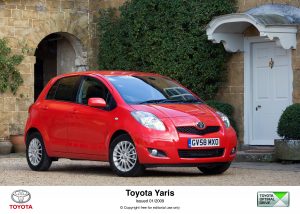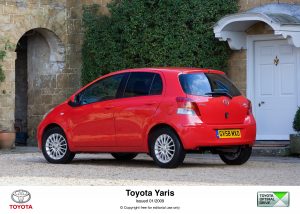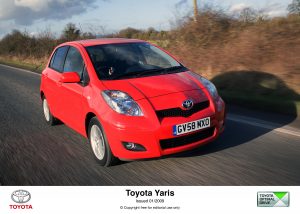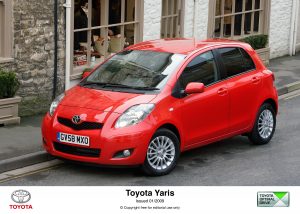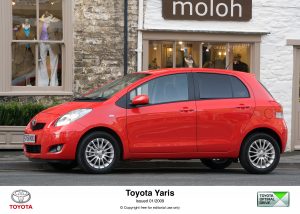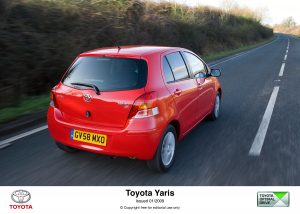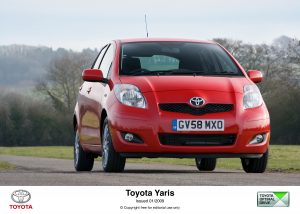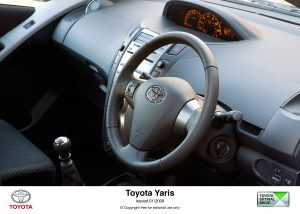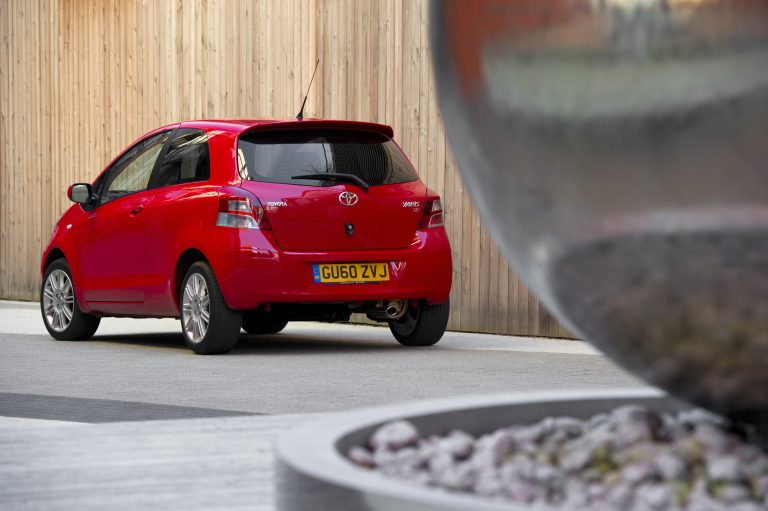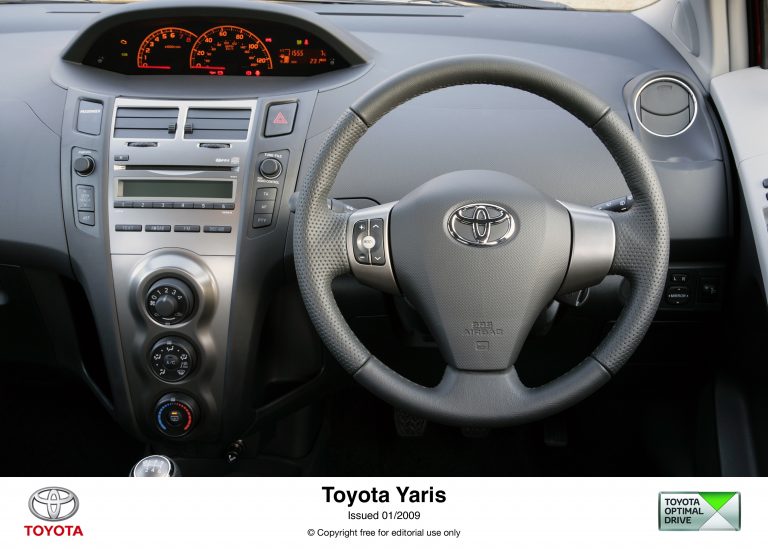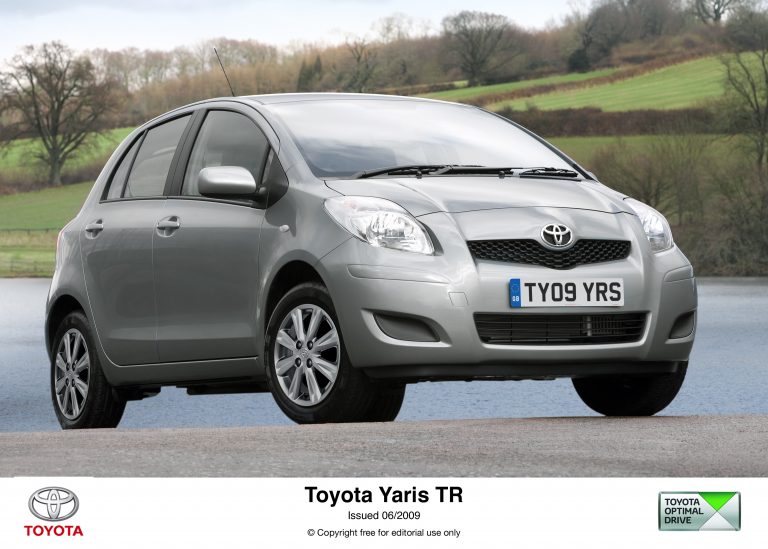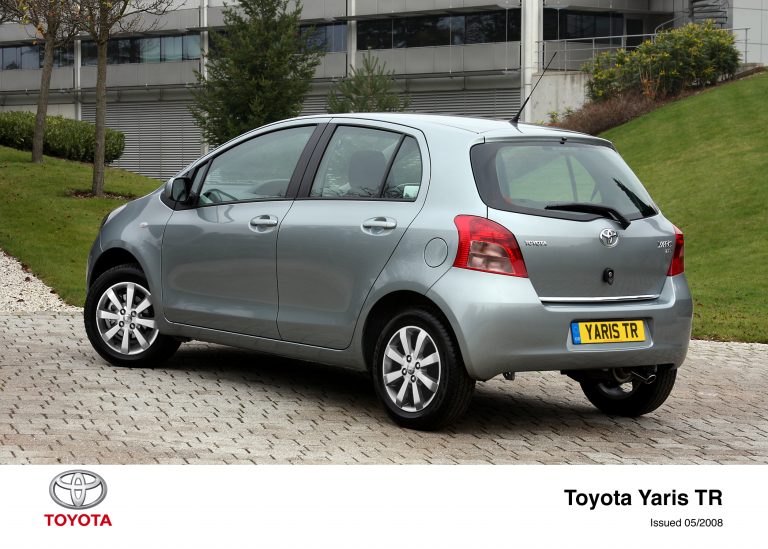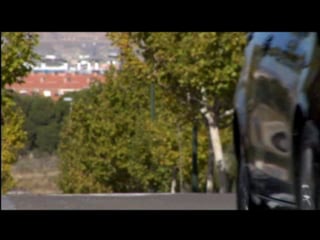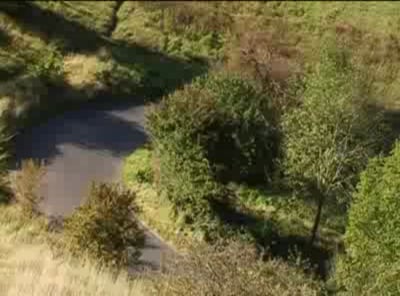2009 Toyota Yaris: Less Is So Much More
This is an archived press release.
For more information on the 2006-2011 Yaris, please visit the Yaris Archive.
Lower emissions and fuel consumption with better performance from new Toyota Optimal Drive power trains
KEY POINTS
- New 1.33-litre Dual VVT-i engine with automatic Stop & Start system, giving best-in-class fuel economy – 55.4mpg (combined)
- Emissions now sub-120g/km for entire Yaris range
- Toyota’s best-selling model substantially re-engineered for 2009 with new front and rear styling details for stronger dynamic appearance
- Toyota Optimal Drive applied to all versions to reduce emissions, improve engine efficiency and cut ownership costs
- New six-speed manual and MultiMode transmissions
- New grade structure – T2, TR, SR and T Spirit
- On sale now, prices from £8,585 on the road
Too often motorists are expected to make sacrifices in performance or comfort for the sake of environmental considerations. Toyota doesn’t believe that needs to be the case and with the launch of its 2009 Yaris demonstrates that lower emissions and fuel consumption can be delivered without compromise.
No model in the new 2009 Toyota Yaris range emits more than 120g/km of carbon dioxide, thanks to the successful adoption of Toyota Optimal Drive across the entire range. At the same time, Yaris is every bit as well-specified, comfortable, reliable and safe as before.
Money-conscious motorists will be encouraged by Yaris’s value compared to its key competitors. Adjusting on-the-road prices in line with equipment specifications, Yaris offers a significant saving. Taking the 1.33 SR five-door model as an example, it represents a price advantage in real terms of up to more than £1,000, against its market rivals, as the table below shows.
|
TOYOTA YARIS 1.33 SR |
FORD FIESTA 1.4 ZETEC |
VAUXHALL CORSA 1.4 SXi A/C |
PEUGEOT 1.4 VTI SPORT |
|
| Doors |
5 |
5 |
5 |
5 |
| OTR price |
£10,915 |
£11,255 |
£11,704 |
£11,793 |
| Stop & Start |
X |
X |
✓ |
X |
| Alloy wheels |
✓ |
✓ |
✓ |
✓ |
| Air conditioning |
✓ |
✓ |
✓ |
X |
| Rear privacy glass |
✓ |
X |
X |
X |
| 6sp transmission |
✓ |
X |
X |
X |
| Curtain airbags |
✓ |
X |
✓ |
✓ |
| Side airbags |
✓ |
X |
✓ |
✓ |
| Knee airbag |
✓ |
✓ |
X |
X |
| Full specification adjusted price |
– |
£11,470 |
£11,734 |
£11,928 |
| Yaris added value |
– |
+£555 |
+£819 |
+£1,103 |
Figures from JATO, correct January 2009
Toyota Optimal Drive
Toyota Optimal Drive, introduced at last year’s Paris motor show, covers a range of technologies that promote greater powertrain efficiency. In line with Toyota’s guiding principle of kaizen – continuous improvement – engineers have improved combustion efficiency, reduced engine and transmission weight and reduced friction to produce engines that deliver more power and are fun to drive, yet at the same time are more efficient and economical.
The 2009 Yaris features a range of new and revised engines that benefit fully from the technical advances delivered by Toyota Optimal Drive. The line-up comprises a new 1.33-litre Dual VVT-i petrol unit with a Stop & Start system and improved versions of the award-winning 1.0-litre VVT-i three-cylinder petrol unit and the 1.4-litre D-4D diesel. A new six-speed manual transmission also debuts in Yaris. Matched to the 1.33 VVT-i and 1.4 D-4D engines, it is smaller, lighter and more efficient than the five-speed gearbox it replaces.
New 1.33 Dual VVT-i Engine
- CO2 emissions from 119g/km
- 55.4mpg combined cycle fuel consumption
- Dual VVT-i valve timing
- Stop & Start system standard with manual transmission
Toyota’s 1.33-litre petrol engine is new to the Yaris range, having made its debut in Auris and new iQ at the end of last year. It features state-of-the-art Dual VVT-i (variable valve timing – intelligent), produces 100bhp (101 DIN hp) and has the highest compression ratio of any petrol engine on the market at 11.5:1.
The in-line four-cylinder unit produces 132Nm of torque at 3,800rpm and returns 55.4mpg in combined cycle driving, with both six-speed manual and MultiMode transmissions.
Applying Toyota Optimal Drive technologies gives the engine superior emissions and fuel consumption performance compared to the previous 1.3-litre unit, reducing CO2 output by 22g/km and improving combined cycle mpg from 47.1 to 55.4 (both figures for manual transmission with Stop & Start). The engine is also smaller and lighter, but produces greater torque.
Advanced engineering was applied through the development of the new engine, with streamlining of the intake channel, and smoothing of surfaces and rounding off of all angles and edges inside the block to improve airflow and reduce turbulence.
Using a resin cylinder head and intake manifold has yielded substantial weight savings and a new, highly rigid aluminium crank case is connected to the transaxle case, which improves the rigidity of the joint in the powertrain and reduces friction and noise levels.
Further changes that benefit all-round performance include a new camshaft profile, reduced friction and weight in the valve gear, and a maintenance-free hydraulic lash adjuster.
Stop & Start Technology
A new Stop & Start system is featured as standard on the 1.33 Dual VVT-i engine with six-speed manual transmission. This automatically stops the engine when the gear shift is moved to neutral and the clutch pedal is released; the engine restarts as soon as the clutch is depressed again.
Immediate restarting is made possible by a permanently engaged gear mechanism and there is no hesitation in a rapid stop and start sequence – the engine does not have to stop fully before firing into life again. The system reduces fuel consumption and CO2 emissions, and operates smoothly and silently.
Leading B-segment on economy, performance and cost of ownership
The introduction of the 1.3 Dual VVT-i engine with Stop & Start gives Yaris a strong competitive edge in the B-segment, delivering performance and emissions that its key competitors simply cannot match. This advantage extends into on-going ownership cost benefits.
While the new engine’s emissions and fuel consumption are better than rival 1.2-litre units, power and torque are also superior to other 1.4-litre power plants.
In performance terms, the Yaris 1.33 delivers 35 per cent more power than the Renault Clio 1.2 and about 25 per cent more than the 1.2 engines in Ford’s new Fiesta and the Vauxhall Corsa and the 1.4 unit in the Volkswagen Polo. At the same time, official combined cycle fuel consumption is 12 per cent lower than the next-best rival, the new Fiesta 1.25.
Within the B-segment the Yaris 1.33 Dual VVT-i is also the only model in its class to fall within band B for Vehicle Excise Duty, giving an annual road fund licence bill for 2008/9 of just £35.
In the longer term the cost benefits quickly accrue. Working on the basis of 12,000 miles drive a year, with fuel at an average 99.9p per litre, owners can save around £600 to £960 over a three-year period in fuel and road tax costs compared to leading competitor models, as the table overleaf illustrates.
|
TOYOTA YARIS 1.33 Dual VVT-I TR |
FORD FIESTA 1.25 STYLE+ |
VAUXHALL CORSA 1.2 ACTIVE |
RENAULT CLIO 1.2 EXPRESSION |
VOLKSWAGEN POLO 1.4 MATCH |
|
| Max. power (bhp) |
100 |
80 |
79 |
75 |
79 |
| Max. torque (Nm) |
132 |
114 |
110 |
105 |
132 |
| CO2 emissions (g/km) |
119 |
133 |
139 |
139 |
150 |
| Combined cycle fuel consumption (mpg) |
55.4 |
49.6 |
48.7 |
47.9 |
44.8 |
| VED 2008/9 |
£35 |
£120 |
£120 |
£120 |
£120 |
| VED 3 years vs Yaris |
– |
+£250 |
+£250 |
+£250 |
+£270 |
| Fuel cost 3 years vs Yaris |
– |
+£351 |
+£405 |
+£461 |
+£697 |
| VED + fuel cost 3 years vs Yaris |
– |
+£601 |
+£655 |
+£711 |
+£967 |
Fuel costs calculated at 99.9p per litre over 12,000 miles driven per annum; VED costs based on current charges for 2008/09, 2009/10 and 2010/11. Competitor data sourced from official manufacturer web sites. All data correct at January 2009.
Award-winning 1.0 VVT-i petrol engine
- CO2 emissions 118g/km
- Fuel consumption 56.5mpg (combined)
Toyota’s three-cylinder VVT-i petrol engine has twice been a category winner in the sub-1.0-litre category of the International Engine of the Year Awards and enters 2009 with even better fuel consumption and emissions performance. Toyota engineers have worked on the unit to deliver the following improvements: –
- A new cut-off system to save fuel during gear changes
- Improvements to the Electronic Fuel Injection (EFI) management
- Use of low viscosity oil for less engine resistance
- Adoption of an exhaust gas recirculation system and cylinder block water jacket spacer to increase efficiency
One of the lightest engines on the market today, it delivers class-leading specific power and torque, with 68bhp (69 DIN hp) at 6,000rpm and 93Nm at 3,600rpm.
TR versions of the 2009 Yaris ride on low rolling resistance tyres, further contributing to lower fuel consumption and CO2 figures. Together the measures achieve a reduction in CO2 of close to 10 per cent compared to the previous model.
Upgraded 1.4 D-4D Diesel Engine
- CO2 emissions 109g/km (manual)
- Combined cycle fuel consumption 68.9mpg (manual)
The 1.4 D-4D diesel engine features latest-generation common rail technology and an intercooled turbocharger. Power has been increased slightly to 89bhp (90 DIN hp) and maximum torque is greater by 15Nm at 205Nm, produced between 1,800 and 2,800rpm, giving more pulling power at lower engine speeds.
Official combined cycle fuel consumption is substantially improved, cut from 62.8 to 68.9mpg with manual transmission, 67.3 with the MultiMode (M/M) gearbox. Likewise emissions have been reduced, falling from 119 to a class-leading 109g/km (110g/km with M/M).
New Six-speed Manual and MultiMode Transmissions
As part of the Toyota Optimal Drive technology applied to the new 2009 Yaris. A six-speed transmission has been developed for the 1.33 Dual VVT-i and 1.4 D-4D 90 engines. This new unit deliverS world-class efficiency and improved fuel economy, thanks to a wider ratio for sixth gear. Driving performance is also enhanced. And shift feel is better, with a new shift structure that is quiet and gives a smooth feel to clutch operation.
A six-speed version of MultiMode, Toyota’s electrically operated (robotised) manual transmission has also been developed and introduced in Yaris. It uses two electric motors and an electronically operated clutch to provide either automatic or sequential gear changes, using three operating modes: M for sequential shifts; E for automatic shifts; and Es for quicker automatic gear changes.
The system has been tuned to give sportier performance than before, with a reduced clutch activation time and the addition of paddle shifts on the steering wheel. With less of an interruption in the driveline during gear shifts, the shift-shock effect has also been reduced.
Evolutionary Yaris Design
Styling changes for the 2009 Yaris are evolutionary, designed to strengthen the car’s dynamic and sophisticated qualities.
Exterior
The bonnet and bumper are more closely integrated, and protection mouldings have been incorporated. Changing the bumper design has increased the car’s overall length by 35mm.
The radiator grille has a new rippled mesh design that radiates out from the central Toyota badge. The larger front spoiler, spats and changes to the underfloor design contribute to the car’s all-round smooth aerodynamics.
The front headlamps have been re-sculpted for a more hi-tech appearance, while at the rear the bumper and integrated LED combination lamps have been refreshed.
Interior
Changes to the interior include a new black finish for the centre console, with titanium silver finish around the centre console, gearshift and steering wheel trim. The steering wheel cover gains silver stitching, and TR, SR and T Spirit models feature a chrome finish for the side vent bezels and parking brake release knob.
Grade Structure
The Yaris grade structure has been revised with two new focus grades, TR and SR, plus the established T2 and T Spirit trim levels.
T2
The entry point to the range, the T2 grade typifies Yaris’s high specifications, with standard features including a leather trimmed steering wheel with tilt and telescopic adjustment and audio controls, electric front windows, remote central locking, rear seats with slide and recline function and 60:40 split-fold, Toyota Easy Flat one-touch rear seat folding system, audio system with Aux-in connection and MP3/WMA file playing capability, driver and passenger front and side airbags and ABS with Electronic Brakeforce Distribution (EBD) and Brake Assist (BA).
TR
TR grade models are expected to account for around 68 per cent of all new Yaris sales, offering a strong combination of equipment features with a competitive price. Among the key features are air conditioning, electric door mirrors, a special TR interior trim design with chrome detailing, six-speaker audio system, driver’s knee airbag and curtain airbags, and body-coloured door mirrors and handles.
SR
SR trim adds a sporty styling dimension to Yaris, introducing 15-inch alloy wheels, front fog lamps, rear privacy glass, dark-tinted headlight covers, sports front grille design, amber-lit analogue speedometer and tachometer, leather trimmed sports steering wheel and special interior trim design.
T Spirit
T Spirit is at the pinnacle of the Yaris range, equipped with 15-inch alloys, front fog lights, automatic air conditioning, Bluetooth, Smart Entry and Start system and an exclusive interior trim design.
Key Equipment Features
| T2 |
TR |
SR |
T SPIRIT |
|
4-speaker audio with CD player, Aux-in and MP3/WMA file playing from disc |
Body coloured, electrically adjustable door mirrors |
15-inch sport alloy wheels |
15-inch alloy wheels |
|
Electric front windows |
6-speaker audio |
Front fog lamps |
Bluetooth |
|
Driver’s seat height adjustment |
Chrome interior trim details |
Rear privacy glass |
Automatic air conditioning |
|
Leather steering wheel trim and gear shift knob |
Curtain airbags |
Smoked headlamp glass |
Smart Entry and Start |
|
Steering wheel audio controls |
Driver’s knee airbag |
Interior sports trim |
Exclusive interior trim design |
|
Steering wheel reach adjustment |
Manual air conditioning |
Analogue meters |
|
|
Body coloured bumpers with corner protection mouldings |
Leather sports steering wheel and gear shift knob |
||
|
Sports front grille |
European Production
Yaris continues to be built at Toyota’s Valenciennes factory in France. The plant began operations in 2001 and now exports cars to 25 countries across Europe. Production capacity was recently increased to a maximum 270,000 units a year.
Valenciennes built its one millionth Yaris in December 2006 and to date has attracted investment of around €897 million. Approximately 3,850 people work at the factory.
Valenciennes was the first Toyota plant outside Japan to adopt the Global Body Line, a configuration of robots that can be programmed to build a number of different vehicle styles, without the entire factory having to be modified.
Although only a single model is built there, it is produced in four derivatives: left and right-hand drive, with petrol or diesel engines. Each version requires different parts and production steps. The flexibility of the Global Body Line can also be harnessed to build completely different models on the same assembly line at the same time.
Environmental Management
Toyota Motor Manufacturing France (TMMF) has achieved a three-year plan target to recover and recycle 100 per cent of the waste products from industrial and housekeeping processes. Having achieved zero waste to landfill since the site opened in 2001, and a 50 per cent reduction in the amount of waste generated, the company has now gone even further by sending no waste for incineration.
Manufacturing a Yaris produces 9.5kg of waste, more than 4kg of which is directly recyclable (cardboard, metal, oil solvents, etc). The remaining 5.5kg are used as substitute fuel, for example in place of oil, in industrial processes.
2009 Yaris prices, VED and insurance
| GRADE | POWERTRAIN | BODY |
OTR PRICE |
VED BAND |
INSURANCE |
| T2 | Toyota Optimal Drive 1.0 VVT-i 5MT | 3-door |
£8,585 |
B |
1E |
| T2 | Toyota Optimal Drive 1.0 VVT-i 5MT | 5-door |
£9,075 |
B |
2E |
| TR | Toyota Optimal Drive 1.0 VVT-i 5MT | 3-door |
£9,540 |
B |
2E |
| TR | Toyota Optimal Drive 1.33 VVT-i 6MT | 3-door |
£10,275 |
B |
3E |
| TR | Toyota Optimal Drive 1.33 VVT-i 6M/M | 3-door |
£10,745 |
B |
3E |
| TR | Toyota Optimal Drive 1.4 D-4D 6MT | 3-door |
£11,125 |
B |
4E |
| TR | Toyota Optimal Drive 1.4 D-4D 6M/M | 3-door |
£11,715 |
B |
4E |
| TR | Toyota Optimal Drive 1.0 VVT-i 5MT | 5-door |
£10,030 |
B |
2E |
| TR | Toyota Optimal Drive 1.33 VVT-i 6MT | 5-door |
£10,765 |
B |
3E |
| TR | Toyota Optimal Drive 1.33 VVT-i 6M/M | 5-door |
£11,235 |
B |
3E |
| TR | Toyota Optimal Drive 1.4 D-4D 6MT | 5-door |
£11,615 |
B |
4E |
| TR | Toyota Optimal Drive 1.4 D-4D 6M/M | 5-door |
£12,205 |
B |
4E |
| SR | Toyota Optimal Drive 1.33 VVT-i 6MT | 3-door |
£10,915 |
B |
4E |
| SR | Toyota Optimal Drive 1.33 VVT-i 6M/M | 3-door |
£11,385 |
B |
4E |
| SR | Toyota Optimal Drive 1.4 D-4D 6MT | 3-door |
£11,765 |
B |
4E |
| SR | Toyota Optimal Drive 1.4 D-4D 6M/M | 3-door |
£12,355 |
B |
4E |
| SR | Toyota Optimal Drive 1.33 VVT-i 6MT | 5-door |
£11,405 |
B |
4E |
| SR | Toyota Optimal Drive 1.33 VVT-i 6M/M | 5-door |
£11,875 |
B |
4E |
| SR | Toyota Optimal Drive 1.4 D-4D 6MT | 5-door |
£12,255 |
B |
4E |
| SR | Toyota Optimal Drive 1.4 D-4D 6M/M | 5-door |
£12,845 |
B |
4E |
| T Spirit | Toyota Optimal Drive 1.33 VVT-i 6MT | 5-door |
£12,005 |
B |
4E |
| T Spirit | Toyota Optimal Drive 1.33 VVT-i 6M/M | 5-door |
£12,475 |
B |
4E |
| T Spirit | Toyota Optimal Drive 1.4 D-4D 6MT | 5-door |
£12,855 |
B |
4E |
| T Spirit | Toyota Optimal Drive 1.4 D-4D 6M/M | 5-door |
£13,455 |
B |
4E |
2009 Yaris options
| OPTION |
GRADES |
PRICE |
| VSC, traction control & rear disc brakes |
All |
£345 |
| Metallic paint |
All |
£370 |
| Protection Pack (rear parking sensors, mudflaps, side mouldings, boot protection plate) |
TR, SR, T Spirit |
£440 |
| Tech Pack (Bluetooth, iPod/iPhone/USB integration kit) |
TR, SR |
£410 |
2009 TOYOTA YARIS TECHNICAL SPECIFICATIONS
| Toyota Optimal Drive 1.0-litre VVT-i petrol | |||||||
| Code |
1KR-FE |
||||||
| Type |
In line transverse 3-cylinder |
||||||
| Valve mechanism |
DOHC 12 valve VVT-i |
||||||
| Bore x stroke (mm) |
71.0 x 84.0 |
||||||
| Displacement (cc) |
998 |
||||||
| Compression ratio |
10.5:1 |
||||||
| Max power (bhp/DIN hp @ rpm) |
68/69 @ 6,000 |
||||||
| Max torque (Nm @ rpm) |
93 @ 3,600 |
||||||
| Toyota Optimal Drive 1.33-litre Dual VVT-i petrol | |||||||
| Code |
1NR-FE |
||||||
| Type |
In line transverse 4-cylinder |
||||||
| Valve mechanism |
DOHC 16 valve Dual VVT-i |
||||||
| Bore x stroke (mm) |
72.5 x 80.5 |
||||||
| Displacement (cc) |
1,329 |
||||||
| Compression ratio |
11.5:1 |
||||||
| Max power (bhp/DIN hp @ rpm) |
100/101 @ 6,000 |
||||||
| Max torque (Nm @ rpm) |
132 @ 3,800 |
||||||
| Toyota Optimal Drive 1.4-litre D-4D 90 diesel | |||||||
| Code |
1ND-TV |
||||||
| Type |
In line transverse 4-cylinder |
||||||
| Valve mechanism |
SOHC 8-valve |
||||||
| Bore x stroke (mm) |
73.0 x 81.5 |
||||||
| Displacement (cc) |
1,364 |
||||||
| Compression ratio |
16.:1 |
||||||
| Max power (bhp/DIN hp @ rpm) |
89/90 @ 3,800 |
||||||
| Max torque (Nm @ rpm) |
205 @ 1,800-2,800 |
||||||
| PERFORMANCE |
1.0 VVT-i |
1.33 Dual VVT-i |
1.33 Dual VVT-i |
1.4 D-4D |
1.4 D-4D |
||
| 0-62mph (sec) |
15.7 |
11.7 |
11.7 |
10.7 |
10.7 |
||
| Maximum speed (mph) |
96 |
109 |
109 |
109 |
109 |
||
| FUEL CONSUMPTION, EMISSIONS & VED | |||||||
| Combined (mpg) |
56.5 |
55.4 |
55.4 |
68.9 |
67.3 |
||
| Urban (mpg) |
47.1 |
45.6 |
45.6 |
55.4 |
55.4 |
||
| Extra Urban (mpg) |
62.8 |
64.3 |
64.2 |
78.5 |
78.5 |
||
| CO2 emissions (g/km) |
118 |
119 (120*) |
119 (120*) |
109 |
110 |
||
| VED band |
B |
B |
B |
B |
B |
||
|
DIMENSIONS |
|||||||
| Overall length (mm) |
3,785 |
||||||
| Overall width (mm) |
1,695 |
||||||
| Overall height (mm) |
1,530 |
||||||
| Wheelbase (mm) |
2,460 |
||||||
| Track width – front (mm) |
1,470 |
||||||
| Track width – rear (mm) |
1,460 |
||||||
| Overhang – front (mm) |
755 |
||||||
| Overhang – rear (mm) |
570 |
||||||
| Interior length (mm) |
1,865 |
||||||
| Interior width (mm) |
1,390 |
||||||
| Interior height (mm) |
1,270 |
||||||
| Head room – front (mm) |
1,000 |
||||||
| Head room – rear (mm) |
963 |
||||||
* SR
TOYOTA YARIS TECHNICAL SPECIFICATIONS contd.
|
DIMENSIONS (Cont) |
||||||||
| Shoulder room – front (mm) |
1,300 |
|||||||
| Shoulder room – rear (mm) |
1,269 |
|||||||
| Leg room – front (mm) |
1,048 |
|||||||
| Leg room – rear (mm) |
865 |
|||||||
| Couple distance (mm) |
880 |
|||||||
| VDA luggage capacity – rear seat up (l) |
272 – 363 |
|||||||
| Boot length – rear seat down (mm) |
477 |
|||||||
| Max. boot width (mm) |
510 |
|||||||
| Boot height (mm) |
767 |
|||||||
| Coefficient of drag (Cd) |
0.30 |
|||||||
| Fuel tank (l) |
42 |
|||||||
|
WEIGHTS |
1.0 VVT-i |
1.33 Dual VVT-i |
1.33 Dual VVT-i |
1.4 D-4D |
1.4 D-4D |
|||
| Kerb weight (kg) |
985-1035 |
1040-1080 |
1040-1070 |
1055-1110 |
1060-1115 |
|||
| Gross vehicle weight (kg) |
1440 |
1480 |
1480 |
1525 |
1525 |
|||
|
SUSPENSION |
||||||||
| Front |
MacPherson struts with anti-roll bar |
|||||||
| Rear |
Torsion beam |
|||||||
|
BRAKES |
||||||||
| Front |
258 mm ventilated discs |
|||||||
| Rear |
203mm drums |
|||||||
| Additional features |
ABS with Electronic Brakeforce Distribution and Brake Assist |
|||||||
| Additional features |
Vehicle Stability Control and Traction Control |
|||||||
|
STEERING |
||||||||
| Type |
Rack and pinion, electric motor power assisted |
|||||||
| Ratio |
14.2:1 |
|||||||
| Turns – lock to lock |
3.0 |
|||||||
| Min turning radius – tyre (m) |
4.7 |
|||||||
| TRANSMISSION |
1.0 VVT-i |
1.33 Dual VVT-i |
1.4 D-4D |
|||||
| Gear ratios | First |
3.545 |
3.538 |
3.538 |
||||
| Second |
1.913 |
1.913 |
1.913 |
|||||
| Third |
1.310 |
1.310 |
1.310 |
|||||
| Fourth |
1.027 |
1.029 |
0.971 |
|||||
| Fifth |
0.850 |
0.875 |
0.714 |
|||||
| Sixth |
– |
0.700 |
0.619 |
|||||
| Reverse |
3.214 |
3.333 |
3.333 |
|||||
| Final drive ratio |
4.411 |
4.053 |
3.550 |
|||||
|
TYRES & WHEELS |
||||||||
| Wheel sizes |
15in steel or alloy |
|||||||
| Tyre sizes |
185/60R15 |
|||||||
| Spare tyre |
Space saver |
|||||||
ENDS

